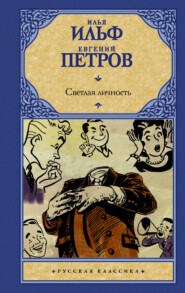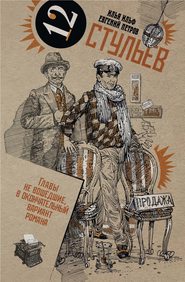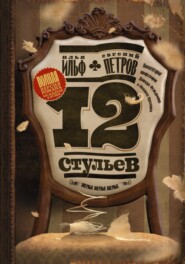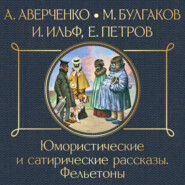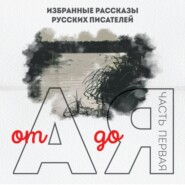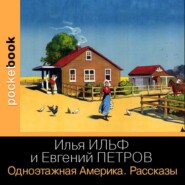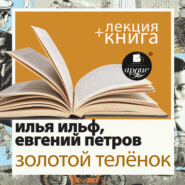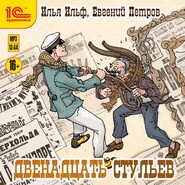По всем вопросам обращайтесь на: info@litportal.ru
(©) 2003-2025.
✖
Одноэтажная Америка / Little Golden America
Автор
Жанр
Серия
Год написания книги
1937
Теги
Настройки чтения
Размер шрифта
Высота строк
Поля
There was, it seemed, such a lady. We began to develop the idea, when Mr. Adams rose suddenly. The lenses of his spectacles began to gleam. He grew serious.
“Gentlemen, we need two days to decide this question.”
For two days we wandered around New York, annoying each other with questions as to what might happen in case the Adamses refused to go on the journey with us. Where will we then find our ideal creature? And we spent a long time in front of stores that sold things for the road. Scotch cloth bags with zippers, rucksacks of sailcloth, soft leather suitcases, plaids, and thermos bottles – everything reminded one of a journey and lured one to start on it.
Exactly at the appointed hour, Mr. Adams appeared in our hotel room. He was unrecognizable. He was solemn and deliberate. All the buttons of his vest were buttoned. Thus the ambassador of a neighbouring friendly power comes to call on the minister of foreign affairs and declares that the government of his excellency considers itself now in a state of war with the power the representative of which is the above-mentioned minister of foreign affairs.
“Mr. Ilf and Mr. Petrov,” said the little fat man, puffing and wiping icy sweat off his bald head, “we have decided to accept your proposal.”
We wanted to embrace him, but he wouldn’t let us, saying:
“This is too serious an occasion, gentlemen. We cannot lose any more time. You must understand it.”
In the course of those two days Mr. Adams not only made up his mind and reached a decision, but he worked out our itinerary in detail. The itinerary made our heads go around.
At first we were to cross the long and narrow state of New York throughout its length, stopping in Schenectady, the city of the electric industry. The next important stop was to be Buffalo.
“It may seem too trivial to take a look at Niagara Falls, gentlemen, but it must be seen.”
Then, along the shore of Lake Erie, we were to proceed to Detroit. There we were to examine the Ford plants. Then on to Chicago. After that the road was to take us into Kansas City. Through Oklahoma we would drive into Texas. From Texas to Santa Fe in the state of New Mexico. Here we visit the Indian territory. Beyond Albuquerque we cross the Rocky Mountains and drive into the Grand Canyon. Then Las Vegas and the famous dam on the Colorado River, Boulder Dam. Then on to California after crossing the Sierra Nevada range. Coming back from the shores of the Pacific Ocean we return along the Mexican border through El Paso, San Antonio, and Houston. Here we go along the Gulf of Mexico. We are now in the Black Belt: Louisiana, Mississippi, Alabama. We stop in New Orleans, and across the northern corner of Florida, through Tallahassee, Savannah, and Charleston, we move toward Washington, the capital of the United States.
Now it is easy to write about it. But then… how many shouts, arguments, attempts to persuade one another! We wanted to go everywhere, but we were limited by time. The entire automobile journey had to be made in two months, not a day longer. The Adamses declared firmly that they could part from their baby for sixty days and no more.
The difficulty now was an automobile: what kind of an automobile to buy?
Although we knew beforehand that we would buy the cheapest automobile that we could find anywhere in the United States, we nevertheless decided to visit the automobile show of 1936. It was the month of November, 1935, and the show had just opened.
On the two stories of the exhibition building, as if by sleight-of-hand, were gathered all the fairy-tale constellations of the American automobile world. There were no orchestras, no palms, no refreshment stands – in a word, there were no additional attractions. The automobiles themselves were so beautiful that nothing else was needed. The chastity of the American technical style consists in this: that the essence of the thing is not spoiled with anything extraneous. An automobile is the object for which people came here, so only that was here. One was free to touch it, one could sit in it, turn its wheel, light its lamps, examine its motor.
The long bodies of expensive Packards, Cadillacs, and Rolls-Royces stood on mirrored stands. On special platforms were specially polished chassis and motors. Nickelled wheels, displaying the elasticity of the springs, were spun around, and gears were shifted to demonstrate their smooth meshing.
Each firm demonstrated its own technical trick, its one improvement, designed to clinch the enticement of the purchaser – upset his, but chiefly his wife’s, equanimity. All the automobiles displayed by the Chrysler firm were gold coloured – there are such bugs, coffee-gold in colour. These automobiles were surrounded by one huge moan. Thin pretty little American women with the blue eyes of vestal virgins were ready to commit murder for the sake of owning such a machine. Their husbands turned pale at the thought that that night they would have to remain alone with their wives, with nowhere to run to. Many, many are the conversations in New York at night after the opening of an automobile show! It goes ill with a man on the opening day of such an exhibit. He will wander for a long time around the marital couch where, cuddling like a kitten, the beloved creature sobs while he pleads:
“But, Mabel, our Plymouth has gone only twenty thousand miles. It’s an ideal car.”
But the lovely creature does not even listen to her husband. She will repeat one thing over and over:
“I want a golden Chrysler!”
And that night the marital couch will be transformed for the husband into an Indian fakir’s couch covered with spikes.
But the low powerful Cords with crystal lights, which during the day are hidden in the fenders for better streamlining, compel one to forget the golden bugs. American women walk into these machines and sit in them by the hour. But they have not the strength to walk out. Their emotions are completely disturbed. They press a button, and the lamps triumphantly creep out of the fenders. They again touch the button, and the lamps hide in their nests, and again nothing is seen on the outside, except the chaste, shining fender.
But everything dims – even the gold and the crystal – before the rare and apparently old-fashioned forms of the huge Rolls-Royces. At first you want to go past these machines. At first you are even surprised that, in the midst of these slick models, hidden lights and golden colours, stand these black simple machines. But on looking closely you discover that therein precisely lies their distinctiveness. Here is a machine for the rest of your life, the machine for exceedingly wealthy old ladies, the machine for princes. Here Mabel discovers that she will never attain complete happiness, that she will never be a princess. Her Frank earns altogether too little money in his office.
Never will this automobile be out of fashion. Never will it grow old, just as diamonds and sables never grow old. Ah, it is terrible even to sit in it! You feel like the lord protector of the seal who has lost the seal and will be instantly dismissed.
We sat a while in a Rolls-Royce, but decided not to buy it. It was too luxurious for us. It would have been of hardly any use on that trying journey which was before us. Besides, it cost many thousands of dollars.
Then we moved from automobile to automobile. We sat in a blue Buick and in a small and cheap Chevrolet. We called forth Cord lights out of their hiding places by pressing a button, we passed our hands over Plymouths, Oldsmobiles, Studebakers, Hudsons, Nashes. We even pressed the horn of a Cadillac, assuming the air that on that alone depended our decision to buy or not to buy. But after evoking a truly marvellous and mighty roar of the steppes from the nether regions of the machine, we walked away. No! We would not buy it! It was not within our means!
We visited other automobile showrooms. They were located for the most part under the open sky on vacant city lots, but all their grandeur was spoiled by a huge sign reading, “Used Automobiles”.
Here also were Studebakers, Oldsmobiles, Hudsons, and Plymouths. But what time had done to them! No repair work could hide their respectable old age.
“These machines are for very wealthy people,” Mr. Adams said suddenly. “I advise you to buy a new Ford. A used car costs little, but you never can tell how many times you will have to repair it on the road nor how much petrol and oil it consumes. No, no, gentlemen! It would be a foolish thing to buy second-hand stuff.”
Although in every one of these markets under a special shed stood an automobile decorated with the attractive placard “Today’s Bargain,” and although we were insanely intent on acquiring this bargain (the price was incredibly low and it looked simply remarkable), Mr. Adams was implacable and restrained us from a dangerous purchase.
We bought a new Ford.
At first we wanted to buy a Ford with a radio set, but we were dissuaded by a terrible story. Not long ago an accident occurred. In the mountains an automobile was smashed. The wounded people lay in it for several hours under the sound of fox-trots broadcast by the surviving radio set. After hearing that we refused to buy a radio. Incidentally, it cost only forty-two dollars.
We also declined to purchase a heater. What’s the use of a heater when you have to keep a window open anyway? Otherwise the wind-shield will sweat. Besides, the heater cost a lot – twelve dollars.
An ash-tray was inexpensive, but we didn’t have the time to buy one.
In a word, we bought the most ordinary Ford, without a radio, without a heater, without an ash-tray, without a rear trunk, but with an electric lighter.
It was sold to us by a dealer in the lower part of town, somewhere on Second Avenue, corner First Street – not the most aristocratic part of the city. Our new automobile, or, as they say in America, the “car,” stood in an empty garage. The garage was dark and dirty, and the dealer looked like a gangster and didn’t even express any special desire to sell us the machine. If we buy it, all right! If we don’t, don’t! Nevertheless, we saw at once that this was just what we had sought. The automobile was quite new, of a sedate mouse colour, looked expensive, yet cost little. What else can one ask in an automobile? Free cakes? – as Mayakovsky used to say. There are no such wonders in the world! We bought it at once.
We fell in love with our new car, and when all the arrangements were over, when we received the documents entitling us to the possession of the machine, when it already had its yellow number 30-99-74, and the inscription “New York,” and was insured against the possibility of our running into anyone, and also against the possibility of someone running into us, when for the first time we drove with our own machine through New York and Mrs. Adams sat at the wheel, while Mr. Adams himself sat beside her – we were very proud and did not understand why the great city did not say anything about it. To make us feel good, old man Adams said that in all his life he had never, never seen a better, more comfortable, and easier riding, and more economical, automobile than ours.
“Yes, it is remarkably comfortable, and it is easy to drive. You were very fortunate that you bought this and no other automobile,” Mrs. Adams confirmed.
We, too, were puffed up with satisfaction at having managed to pick out the very best automobile out of the twenty-five million automobiles in America.
We spent the last night with the Adamses.
We decided to rise as early as possible and drive off while poor Baby was still asleep. But we failed in that. The little girl discovered us in the act of moving suitcases. It was pitiful to look at the Adamses. With lying voices they assured Baby that they would return in an hour. The Negress wept. We felt that we were utter scoundrels.
The machine glided over the damp asphalt of Central Park West. The speedometer began to register miles. We started on our long trek.
Part II. Through the eastern states
10. On the Automobile Highway
THE PROUD towers of New York were behind us. Framed in stainless steel, the facets of the Empire State Building shone in the morning murkiness hovering over the gigantic city. A thin mist enveloped the summits of Radio City, Chrysler, Woolworth, and other skyscrapers, named and unnamed. Now we were driving through a lively and unpretentious suburb.
Muddy water ran over the pavement, which was lined with parallel strips. The green iron trestle of the elevated railway slit the street lengthwise at the height of the fifth story. The high-strung people of New York raced in their automobiles on their sundry errands. A striped barber pole flashed by; it was a revolving glass cylinder with green, red, and blue stripes. In a red-brick house toasted sandwiches were sold. As a matter of fact, all the houses here were brick and all were red. What can one like here, what can one learn to love here?
Like all the large cities of the world, New York is an appalling city. Here millions of people bravely struggle for mere existence. There is too much money in this city. Some people have too much while others have too little. And it is this that casts a tragic light on all that happens in New York.
We parted from the city for two months.
The route of the first day was clear. We were going to Schenectady along U.S. Highway No. 9, through Poughkeepsie (it actually takes twelve letters to write that word in English), the Hudson, and the capital of the state of New York, Albany.
The regimen of the journey was also clear. We had at our disposal sixty days, and we had approximately ten thousand miles to cover in that time. Even if we were to drive at the rate of two hundred and fifty miles a day, we would cover that distance in forty days. We set aside fifteen days for surveys, sightseeing, and so forth. All told, fifty-five days. That left us with five days in reserve for unforeseen developments. To this it should be added that a mile consists of one and six-tenth kilometres.
“Gentlemen, we need two days to decide this question.”
For two days we wandered around New York, annoying each other with questions as to what might happen in case the Adamses refused to go on the journey with us. Where will we then find our ideal creature? And we spent a long time in front of stores that sold things for the road. Scotch cloth bags with zippers, rucksacks of sailcloth, soft leather suitcases, plaids, and thermos bottles – everything reminded one of a journey and lured one to start on it.
Exactly at the appointed hour, Mr. Adams appeared in our hotel room. He was unrecognizable. He was solemn and deliberate. All the buttons of his vest were buttoned. Thus the ambassador of a neighbouring friendly power comes to call on the minister of foreign affairs and declares that the government of his excellency considers itself now in a state of war with the power the representative of which is the above-mentioned minister of foreign affairs.
“Mr. Ilf and Mr. Petrov,” said the little fat man, puffing and wiping icy sweat off his bald head, “we have decided to accept your proposal.”
We wanted to embrace him, but he wouldn’t let us, saying:
“This is too serious an occasion, gentlemen. We cannot lose any more time. You must understand it.”
In the course of those two days Mr. Adams not only made up his mind and reached a decision, but he worked out our itinerary in detail. The itinerary made our heads go around.
At first we were to cross the long and narrow state of New York throughout its length, stopping in Schenectady, the city of the electric industry. The next important stop was to be Buffalo.
“It may seem too trivial to take a look at Niagara Falls, gentlemen, but it must be seen.”
Then, along the shore of Lake Erie, we were to proceed to Detroit. There we were to examine the Ford plants. Then on to Chicago. After that the road was to take us into Kansas City. Through Oklahoma we would drive into Texas. From Texas to Santa Fe in the state of New Mexico. Here we visit the Indian territory. Beyond Albuquerque we cross the Rocky Mountains and drive into the Grand Canyon. Then Las Vegas and the famous dam on the Colorado River, Boulder Dam. Then on to California after crossing the Sierra Nevada range. Coming back from the shores of the Pacific Ocean we return along the Mexican border through El Paso, San Antonio, and Houston. Here we go along the Gulf of Mexico. We are now in the Black Belt: Louisiana, Mississippi, Alabama. We stop in New Orleans, and across the northern corner of Florida, through Tallahassee, Savannah, and Charleston, we move toward Washington, the capital of the United States.
Now it is easy to write about it. But then… how many shouts, arguments, attempts to persuade one another! We wanted to go everywhere, but we were limited by time. The entire automobile journey had to be made in two months, not a day longer. The Adamses declared firmly that they could part from their baby for sixty days and no more.
The difficulty now was an automobile: what kind of an automobile to buy?
Although we knew beforehand that we would buy the cheapest automobile that we could find anywhere in the United States, we nevertheless decided to visit the automobile show of 1936. It was the month of November, 1935, and the show had just opened.
On the two stories of the exhibition building, as if by sleight-of-hand, were gathered all the fairy-tale constellations of the American automobile world. There were no orchestras, no palms, no refreshment stands – in a word, there were no additional attractions. The automobiles themselves were so beautiful that nothing else was needed. The chastity of the American technical style consists in this: that the essence of the thing is not spoiled with anything extraneous. An automobile is the object for which people came here, so only that was here. One was free to touch it, one could sit in it, turn its wheel, light its lamps, examine its motor.
The long bodies of expensive Packards, Cadillacs, and Rolls-Royces stood on mirrored stands. On special platforms were specially polished chassis and motors. Nickelled wheels, displaying the elasticity of the springs, were spun around, and gears were shifted to demonstrate their smooth meshing.
Each firm demonstrated its own technical trick, its one improvement, designed to clinch the enticement of the purchaser – upset his, but chiefly his wife’s, equanimity. All the automobiles displayed by the Chrysler firm were gold coloured – there are such bugs, coffee-gold in colour. These automobiles were surrounded by one huge moan. Thin pretty little American women with the blue eyes of vestal virgins were ready to commit murder for the sake of owning such a machine. Their husbands turned pale at the thought that that night they would have to remain alone with their wives, with nowhere to run to. Many, many are the conversations in New York at night after the opening of an automobile show! It goes ill with a man on the opening day of such an exhibit. He will wander for a long time around the marital couch where, cuddling like a kitten, the beloved creature sobs while he pleads:
“But, Mabel, our Plymouth has gone only twenty thousand miles. It’s an ideal car.”
But the lovely creature does not even listen to her husband. She will repeat one thing over and over:
“I want a golden Chrysler!”
And that night the marital couch will be transformed for the husband into an Indian fakir’s couch covered with spikes.
But the low powerful Cords with crystal lights, which during the day are hidden in the fenders for better streamlining, compel one to forget the golden bugs. American women walk into these machines and sit in them by the hour. But they have not the strength to walk out. Their emotions are completely disturbed. They press a button, and the lamps triumphantly creep out of the fenders. They again touch the button, and the lamps hide in their nests, and again nothing is seen on the outside, except the chaste, shining fender.
But everything dims – even the gold and the crystal – before the rare and apparently old-fashioned forms of the huge Rolls-Royces. At first you want to go past these machines. At first you are even surprised that, in the midst of these slick models, hidden lights and golden colours, stand these black simple machines. But on looking closely you discover that therein precisely lies their distinctiveness. Here is a machine for the rest of your life, the machine for exceedingly wealthy old ladies, the machine for princes. Here Mabel discovers that she will never attain complete happiness, that she will never be a princess. Her Frank earns altogether too little money in his office.
Never will this automobile be out of fashion. Never will it grow old, just as diamonds and sables never grow old. Ah, it is terrible even to sit in it! You feel like the lord protector of the seal who has lost the seal and will be instantly dismissed.
We sat a while in a Rolls-Royce, but decided not to buy it. It was too luxurious for us. It would have been of hardly any use on that trying journey which was before us. Besides, it cost many thousands of dollars.
Then we moved from automobile to automobile. We sat in a blue Buick and in a small and cheap Chevrolet. We called forth Cord lights out of their hiding places by pressing a button, we passed our hands over Plymouths, Oldsmobiles, Studebakers, Hudsons, Nashes. We even pressed the horn of a Cadillac, assuming the air that on that alone depended our decision to buy or not to buy. But after evoking a truly marvellous and mighty roar of the steppes from the nether regions of the machine, we walked away. No! We would not buy it! It was not within our means!
We visited other automobile showrooms. They were located for the most part under the open sky on vacant city lots, but all their grandeur was spoiled by a huge sign reading, “Used Automobiles”.
Here also were Studebakers, Oldsmobiles, Hudsons, and Plymouths. But what time had done to them! No repair work could hide their respectable old age.
“These machines are for very wealthy people,” Mr. Adams said suddenly. “I advise you to buy a new Ford. A used car costs little, but you never can tell how many times you will have to repair it on the road nor how much petrol and oil it consumes. No, no, gentlemen! It would be a foolish thing to buy second-hand stuff.”
Although in every one of these markets under a special shed stood an automobile decorated with the attractive placard “Today’s Bargain,” and although we were insanely intent on acquiring this bargain (the price was incredibly low and it looked simply remarkable), Mr. Adams was implacable and restrained us from a dangerous purchase.
We bought a new Ford.
At first we wanted to buy a Ford with a radio set, but we were dissuaded by a terrible story. Not long ago an accident occurred. In the mountains an automobile was smashed. The wounded people lay in it for several hours under the sound of fox-trots broadcast by the surviving radio set. After hearing that we refused to buy a radio. Incidentally, it cost only forty-two dollars.
We also declined to purchase a heater. What’s the use of a heater when you have to keep a window open anyway? Otherwise the wind-shield will sweat. Besides, the heater cost a lot – twelve dollars.
An ash-tray was inexpensive, but we didn’t have the time to buy one.
In a word, we bought the most ordinary Ford, without a radio, without a heater, without an ash-tray, without a rear trunk, but with an electric lighter.
It was sold to us by a dealer in the lower part of town, somewhere on Second Avenue, corner First Street – not the most aristocratic part of the city. Our new automobile, or, as they say in America, the “car,” stood in an empty garage. The garage was dark and dirty, and the dealer looked like a gangster and didn’t even express any special desire to sell us the machine. If we buy it, all right! If we don’t, don’t! Nevertheless, we saw at once that this was just what we had sought. The automobile was quite new, of a sedate mouse colour, looked expensive, yet cost little. What else can one ask in an automobile? Free cakes? – as Mayakovsky used to say. There are no such wonders in the world! We bought it at once.
We fell in love with our new car, and when all the arrangements were over, when we received the documents entitling us to the possession of the machine, when it already had its yellow number 30-99-74, and the inscription “New York,” and was insured against the possibility of our running into anyone, and also against the possibility of someone running into us, when for the first time we drove with our own machine through New York and Mrs. Adams sat at the wheel, while Mr. Adams himself sat beside her – we were very proud and did not understand why the great city did not say anything about it. To make us feel good, old man Adams said that in all his life he had never, never seen a better, more comfortable, and easier riding, and more economical, automobile than ours.
“Yes, it is remarkably comfortable, and it is easy to drive. You were very fortunate that you bought this and no other automobile,” Mrs. Adams confirmed.
We, too, were puffed up with satisfaction at having managed to pick out the very best automobile out of the twenty-five million automobiles in America.
We spent the last night with the Adamses.
We decided to rise as early as possible and drive off while poor Baby was still asleep. But we failed in that. The little girl discovered us in the act of moving suitcases. It was pitiful to look at the Adamses. With lying voices they assured Baby that they would return in an hour. The Negress wept. We felt that we were utter scoundrels.
The machine glided over the damp asphalt of Central Park West. The speedometer began to register miles. We started on our long trek.
Part II. Through the eastern states
10. On the Automobile Highway
THE PROUD towers of New York were behind us. Framed in stainless steel, the facets of the Empire State Building shone in the morning murkiness hovering over the gigantic city. A thin mist enveloped the summits of Radio City, Chrysler, Woolworth, and other skyscrapers, named and unnamed. Now we were driving through a lively and unpretentious suburb.
Muddy water ran over the pavement, which was lined with parallel strips. The green iron trestle of the elevated railway slit the street lengthwise at the height of the fifth story. The high-strung people of New York raced in their automobiles on their sundry errands. A striped barber pole flashed by; it was a revolving glass cylinder with green, red, and blue stripes. In a red-brick house toasted sandwiches were sold. As a matter of fact, all the houses here were brick and all were red. What can one like here, what can one learn to love here?
Like all the large cities of the world, New York is an appalling city. Here millions of people bravely struggle for mere existence. There is too much money in this city. Some people have too much while others have too little. And it is this that casts a tragic light on all that happens in New York.
We parted from the city for two months.
The route of the first day was clear. We were going to Schenectady along U.S. Highway No. 9, through Poughkeepsie (it actually takes twelve letters to write that word in English), the Hudson, and the capital of the state of New York, Albany.
The regimen of the journey was also clear. We had at our disposal sixty days, and we had approximately ten thousand miles to cover in that time. Even if we were to drive at the rate of two hundred and fifty miles a day, we would cover that distance in forty days. We set aside fifteen days for surveys, sightseeing, and so forth. All told, fifty-five days. That left us with five days in reserve for unforeseen developments. To this it should be added that a mile consists of one and six-tenth kilometres.






